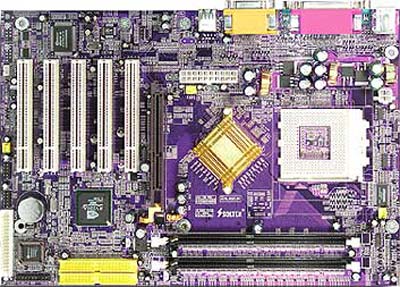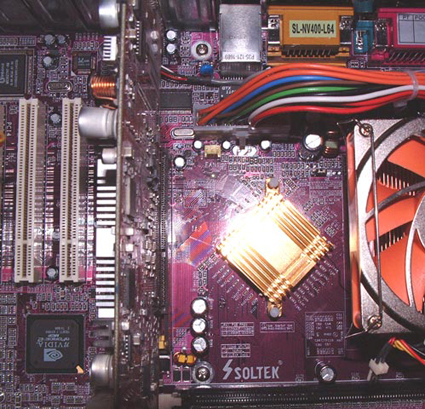Soltek NV400-L64: Purple, Practical, AND Performance!
by Wesley Fink on August 11, 2003 10:26 PM EST- Posted in
- Motherboards
Soltek NV400-L64: Board Layout
The Soltek has a decent layout for a low-end board. We say this because low-end boards often have some of the strangest layouts. When the manufacturer is aiming for a price point, economy of manufacture is often more important than ergonomics.
The first hint that the NV400-L64 may be a serious performer is the inclusion of both the standard 20-pin ATX connector and the AMD optional 4-pin 12V connector. While top-end AMD motherboards are implementing both of these standards, which are part of the Pentium 4 Power Supply specification, we were somewhat amazed to see both connectors on a value board. Regardless, the location of the 20-pin and the 4-pin power connectors are less than ideal. The 20-pin ATX is located to the left of the Northbridge chip, almost in the center of the board. This means you will have to snake the bulky 20-pin cable around your CPU socket and try to keep it from interfering with ventilation. We prefer a location as near to the top of the board as possible and to the right of the CPU. This works best in most case designs. The 4-pin 12V connector is in a common location, to the left of the CPU socket, but it is thankfully at the top of the board. While we prefer the 12V to the right of the CPU socket, between the CPU and DIMM slots and as close to the top of the board as possible, we can’t complain about Soltek’s positioning of the 12V connector — it does not interfere with air-flow or present cable-routing problems.
Fan connections are often in short supply on low-end boards, but Soltek includes three fan headers on the NV400-L64. This allows connection of up to three monitored fans to the board.

The passive heatsink used on the Northbridge has the advantage of not adding to system noise, but the one Soltek used on the NV400-L64 is much smaller than we have seen on other nForce2 boards. While it cooled effectively in our testing, it did get warmer than desired. Those planning any serious overclocking with this board may want to replace the Northbridge heatsink with a larger passive heatsink or an active cooling solution.
One advantage of a small passive or active Northbridge cooling solution is that it won’t interfere with mounting some of the larger CPU cooling solutions. There is plenty of room around the CPU socket, and we don’t believe mounting a large cooler on the CPU will create any problems. The Thermalright SK-7, which uses a clip for connection, fits with ease — even with an 80mm fan attached. However, there are no mounting holes around the CPU socket, which will be important to some. The mounting holes are not part of the current AMD specification, and we didn’t expect to find them on a value board, but they are important to many who use watercooling and very heavy heatsinks.
The Floppy connector and Primary/Secondary IDE connectors are all in compromised positions — predictable for a low-priced board. All three connectors are low on the board, which makes snaking cables more difficult. The floppy connector is in a particularly bad location, situated at the very bottom of the board. At least Soltek kept the connector to the far right of the board, which will minimize interference with slots. But Soltek is no worse than other low-end boards with respect to cable locations. A smaller board means less room to put things, and some of the small boards face some real challenges regarding layout. Our preference is closer to the top of the board, to the right of the DIMM slots; however the smaller board offers no room for the cable connections in that location.
If you have a case with drive bays to the right of the motherboard, the location of the IDE/Floppy connectors near the bottom right of the board will seem ideal. However, if your drives must mount in the upper bays of a tower case, you will probably hate the location of the IDE connectors. In the real world, users with full-tower cases will not likely choose a low-end board like the Soltek to go in their expensive cases. The Soltek layout, therfore, should work fine in the small to mid-size cases that will actually be used with this board.










35 Comments
View All Comments
Anonymous User - Saturday, August 16, 2003 - link
Wesley -I thought the PCI bus runs at a fixed frequency and is independent from the AGP bus. In the review, it was stated that the PCI bus is half of the AGP bus. Is it possible that this could be confirmed with a hardware monitor that is capable of measuring the PCI bus speed? If not, from what source was the PCI bus speed information taken from?
Thanx for review! :D
Anonymous User - Friday, August 15, 2003 - link
#23, you're clueless. AnandTech still has the best motherboard, CPU and now memory reviews on the net. HardOCP does some of the best video card reviews on the net, a bit better than AnandTech, but that's mostly because Anandtech doesn't release any individual video card reviews. If they did, Anandtech would dominate CPU, motherboard, video AND memory reviews.Read other web sites before you belittle Anandtech for quality reviews.
LMAO at #24. Though your point could have been made better without the swearing. :)
Anonymous User - Thursday, August 14, 2003 - link
Yeah Well ,This review is slightly amusing &Mildly Boring..
For all you new guys at AnandTech,
This place does not feel like "Home" anymore..
Oh yes ,its still my homepage ,after so many years.
The Place Might be Anand's - But it aint Anandtech no more...
THe reviews are lacking & incomplete - with too much cutting & pasting done all the time.
Many issues are just ignored ,
& it all feels so shallow.......
You Should Go Read "Old" Coppermine Area AnandTech Archives & get a grip on what this place used to be...
Please hear My (our?!) cry ..
Locutus4657 - Thursday, August 14, 2003 - link
#5:What the heck are you talking about? Via? Better Stability?? You've obviously never looked into their white papers before.... More than 200 pages for the KT133 errata section alone. I'm sorry, It's worth getting fewer features for an nForce board. At least it will work.
Anonymous User - Thursday, August 14, 2003 - link
Why is it that drivers get so little attention, but small differences in performance are blown up well beyond reasonable proportions? I'm talking about reviews all over the net now and not just Anandtech. It's just that the nForce drivers continuing mess doesn't get even a tenth of the attention that benchmarks in stupid programs like SiSoft Sandra get. (?!?)Wich bothers the users most, a few percentages here and there that doesn't show in practical use or driver issues that makes the regular user call his or her "techy" friend to come solve the issues.
Anonymous User - Thursday, August 14, 2003 - link
Actually, we are only on a limitted relationship with Crucial, Corsair, Kingston and Mushkin. They all send us lots of products, but its fairly easy to do considering how much (or how little) a stick of DDR costs.Evan Lieb - Tuesday, August 12, 2003 - link
In case anyone is wondering, all nForce2 Ultra 400 motherboards from Epox, ASUS, ABIT, etc. vary on an average of 0-1.5% (max). In fact, Gigabyte's nForce2 Ultra 400 motherboard (7NNXP) was ever so slightly faster than ASUS's A7N8X Deluxe rev. 2.0In other words, it serves no purpose to run benchmarks on 10 different nForce2 Ulra 400 motherboards if they all perform the same (unless it's a roundup of course).
Wesley Fink - Tuesday, August 12, 2003 - link
All our benchmarks are run at 1024x768 and at 32bit color if possible. We run the GunMetal 2 bench at default settings - which is audio enabled and 2X Anisotropic filtering. It has been common practice NOT to run Quake3 and other game benches with sound enabled due to the variation in scores caused by different sound chips. However with this new DX9 bench, we decided to run at default.Unfortunately, GunMetal 2 seems VERY video-card bound, and may not be a very useful benchmark for motherboard testing. It would appear a great choice, though, for testing video cards.
Anonymous User - Tuesday, August 12, 2003 - link
Wesley could you please state what settings the gunmetal benchs were run including the resolution, graphical settings ect.. I would like to compare my setup to your results. This info would be benificial if it was stated in the result graphic in the article. Thanks.Wesley Fink - Tuesday, August 12, 2003 - link
#14 - As we stated in #10 and #12, we recently completed retesting ALL recent reviews with our new ATI 9800 PRO video standard. When that was done, benchmarks for this review were updated and sent to our editor who does web-posting.Unfortunately, our web-editor posted the earlier tests. These have NOW been corrected and all reported benchmarks are with the 9800 PRO.
It helps to read all the comments before posting here. Your question or comment may already have been addressed.